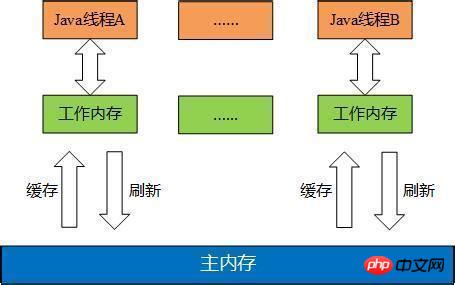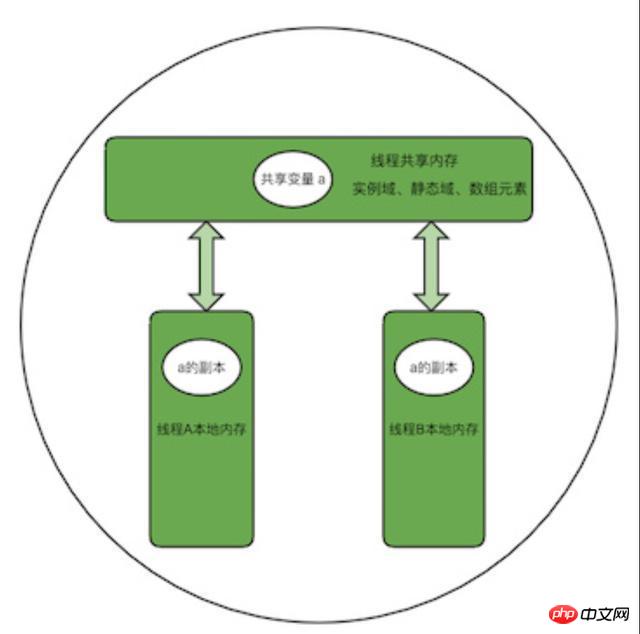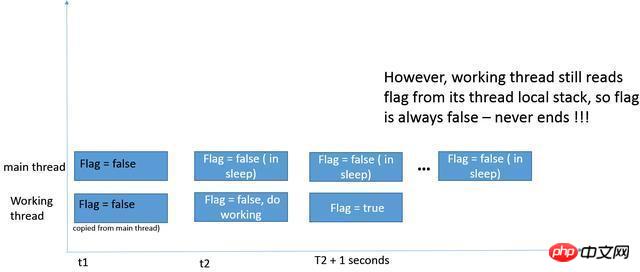Code analysis of Java volatile keyword
The content of this article is about the code analysis of Java volatile keyword. It has certain reference value. Friends in need can refer to it. I hope it will be helpful to you.
I believe that most Java programmers have learned how to use the volatile keyword. The definition of volatile on Baidu Encyclopedia:
volatile is a type modifier (type specifier) designed to modify variables that are accessed and modified by different threads. volatile functions as an instruction keyword to ensure that this instruction will not be omitted due to compiler optimization and requires direct reading of the value each time.
There may be many friends who have just learned Java who still feel confused after reading the very general description above.
Below we will use a specific example to learn the usage of volatile.
Look at this example:
public class ThreadVerify {
public static Boolean stop = false;
public static void main(String args[]) throws InterruptedException {
Thread testThread = new Thread(){
@Override
public void run(){
int i = 1;
while(!stop){
//System.out.println("in thread: " + Thread.currentThread() + " i: " + i);
i++;
}
System.out.println("Thread stop i="+ i);
}
}
;
testThread.start();
Thread.sleep(1000);
stop = true;
System.out.println("now, in main thread stop is: " + stop);
testThread.join();
}
}This code defines a Boolean variable stop in the second line of the main thread, and then the main thread starts a new thread and keeps increasing the counter in the thread. The value of i will not end the loop until the Boolean variable stop of the main thread is set to true by the main thread.
The main thread uses Thread.sleep to pause for 1 second and then set the Boolean value stop to true.

Therefore, the result we expect is that the above Java code stops after executing for 1 second, and prints out the actual value of counter i within 1 second value.
However, after executing this Java application, you find that it enters an infinite loop, and you find in the task manager that the CPU usage of this Java program soars.
what is the reason? Let us review the memory model knowledge taught in the computer major course Operating Systems.
Take the Java memory model as an example. The Java memory model is divided into main memory (main memory) and work memory (work memory). The variables in the main memory are shared by all threads. Each thread has its own working memory, and the variables inside include thread-local variables. If a variable in main memory is used by a thread, the thread's working memory will maintain a copy of the main memory variable.

All read and write operations by a thread on variables must be performed in the working memory, and variables in the main memory cannot be directly manipulated. Different threads cannot directly access each other's working memory. The transfer of variables between threads needs to be completed through main memory. The interactive relationship between threads, main memory, and working memory is as follows:

If the thread modifies the definition in its own execution code, Variables in the main thread (main memory) are modified directly in the thread's working memory, and then at a certain moment (the Java programmer cannot control this moment, but is scheduled by the JVM), this modification is written back from the working memory. main memory.
Back to our example. Although the main thread modifies the stop variable, it only modifies the value in the main memory, while the stop variable in the working memory of the thread that operates the counter still has the old value, which is always false. Therefore this thread is stuck in an infinite loop.

Once you know the principle, the solution is simple. Add the keyword volatile before the stop variable to modify it, so that every time the stop value is read in the counter thread, volatile will force the thread to read from the main memory instead of reading from the working memory of the current thread. This avoids an infinite loop. The picture below shows that after 1 second, the counter has executed 1.4 billion times.

The above is the detailed content of Code analysis of Java volatile keyword. For more information, please follow other related articles on the PHP Chinese website!

Hot AI Tools

Undresser.AI Undress
AI-powered app for creating realistic nude photos

AI Clothes Remover
Online AI tool for removing clothes from photos.

Undress AI Tool
Undress images for free

Clothoff.io
AI clothes remover

Video Face Swap
Swap faces in any video effortlessly with our completely free AI face swap tool!

Hot Article

Hot Tools

Notepad++7.3.1
Easy-to-use and free code editor

SublimeText3 Chinese version
Chinese version, very easy to use

Zend Studio 13.0.1
Powerful PHP integrated development environment

Dreamweaver CS6
Visual web development tools

SublimeText3 Mac version
God-level code editing software (SublimeText3)

Hot Topics
 1389
1389
 52
52
 Perfect Number in Java
Aug 30, 2024 pm 04:28 PM
Perfect Number in Java
Aug 30, 2024 pm 04:28 PM
Guide to Perfect Number in Java. Here we discuss the Definition, How to check Perfect number in Java?, examples with code implementation.
 Weka in Java
Aug 30, 2024 pm 04:28 PM
Weka in Java
Aug 30, 2024 pm 04:28 PM
Guide to Weka in Java. Here we discuss the Introduction, how to use weka java, the type of platform, and advantages with examples.
 Smith Number in Java
Aug 30, 2024 pm 04:28 PM
Smith Number in Java
Aug 30, 2024 pm 04:28 PM
Guide to Smith Number in Java. Here we discuss the Definition, How to check smith number in Java? example with code implementation.
 Java Spring Interview Questions
Aug 30, 2024 pm 04:29 PM
Java Spring Interview Questions
Aug 30, 2024 pm 04:29 PM
In this article, we have kept the most asked Java Spring Interview Questions with their detailed answers. So that you can crack the interview.
 Break or return from Java 8 stream forEach?
Feb 07, 2025 pm 12:09 PM
Break or return from Java 8 stream forEach?
Feb 07, 2025 pm 12:09 PM
Java 8 introduces the Stream API, providing a powerful and expressive way to process data collections. However, a common question when using Stream is: How to break or return from a forEach operation? Traditional loops allow for early interruption or return, but Stream's forEach method does not directly support this method. This article will explain the reasons and explore alternative methods for implementing premature termination in Stream processing systems. Further reading: Java Stream API improvements Understand Stream forEach The forEach method is a terminal operation that performs one operation on each element in the Stream. Its design intention is
 TimeStamp to Date in Java
Aug 30, 2024 pm 04:28 PM
TimeStamp to Date in Java
Aug 30, 2024 pm 04:28 PM
Guide to TimeStamp to Date in Java. Here we also discuss the introduction and how to convert timestamp to date in java along with examples.
 Java Program to Find the Volume of Capsule
Feb 07, 2025 am 11:37 AM
Java Program to Find the Volume of Capsule
Feb 07, 2025 am 11:37 AM
Capsules are three-dimensional geometric figures, composed of a cylinder and a hemisphere at both ends. The volume of the capsule can be calculated by adding the volume of the cylinder and the volume of the hemisphere at both ends. This tutorial will discuss how to calculate the volume of a given capsule in Java using different methods. Capsule volume formula The formula for capsule volume is as follows: Capsule volume = Cylindrical volume Volume Two hemisphere volume in, r: The radius of the hemisphere. h: The height of the cylinder (excluding the hemisphere). Example 1 enter Radius = 5 units Height = 10 units Output Volume = 1570.8 cubic units explain Calculate volume using formula: Volume = π × r2 × h (4
 Create the Future: Java Programming for Absolute Beginners
Oct 13, 2024 pm 01:32 PM
Create the Future: Java Programming for Absolute Beginners
Oct 13, 2024 pm 01:32 PM
Java is a popular programming language that can be learned by both beginners and experienced developers. This tutorial starts with basic concepts and progresses through advanced topics. After installing the Java Development Kit, you can practice programming by creating a simple "Hello, World!" program. After you understand the code, use the command prompt to compile and run the program, and "Hello, World!" will be output on the console. Learning Java starts your programming journey, and as your mastery deepens, you can create more complex applications.




